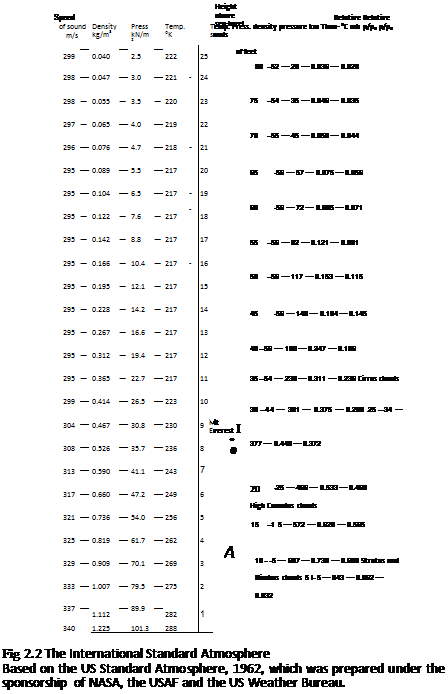Temperature changes in the atmosphere
Another change which takes place as we travel upwards through the lower layers of the atmosphere is the gradual drop in temperature, a fact which unhappily disposes of one of the oldest legends about flying – that of Daedalus and his son Icarus, whose wings were attached by wax which melted because he flew too near the sun. In most parts of the world, the atmospheric temperature falls off at a steady rate called the lapse rate of about —6.5°C for every 1000 metres increase in height up to about 11000 metres. Above 11000 metres, the temperature remains nearly constant until the outer regions of the atmosphere are reached. The portion of the atmosphere below the height at which the change occurs is called the troposphere, and the portion above, the stratosphere. The interface between the two is called the tropopause. The lapse rate and the height of the tropopause vary with latitude. In Arctic regions, the rate of temperature change is lower, and the stratosphere does not start until around 15 500 m. The temperature in the stratosphere varies between about — 30°C at the equator to —95°C in the Arctic. In temperate regions such as Europe the temperature in the stratosphere is around —56.5°C.
For aircraft performance calculations, it is normal practice to use a standard set of conditions called the International Standard Atmosphere (ISA). This defines precise values of lapse rate, height of the tropopause, and sea-level values of temperature, pressure and density. For temperate regions the ISA
 |
value of the lapse rate is —6.5°C per 1000 m, the tropopause is at 11 km, and the sea-level values of pressure and temperature are 101.325 kN/m2, and 15°C respectively.
Modern long – and medium-range airliners cruise in or very close to the stratosphere, and the supersonic airliner Concorde used to fly in the stratosphere well above the tropopause. When piston-engined aircraft first started to fly in the stratosphere, conditions were very uncomfortable for the crew. The low density and pressure meant that oxygen masks had to be worn, and at temperatures of —56°C, even the heavy fur-lined clothing was barely adequate. Nowadays, the cabins of high-flying airliners are pressurised, and the air is heated, so that the passengers are unaware of the external conditions. Nevertheless, above every seat there is an emergency oxygen mask to be used in the event of a sudden failure of the pressurisation system.
Despite the low external air temperature in the stratosphere, supersonic aircraft have the problem that surface friction heats the aircraft up during flight, so means have to be provided to keep the cabin cool enough.











